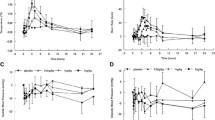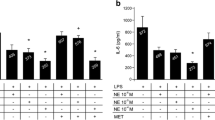Abstract
Pretreatment of super-low-dose lipopolysaccharide (SL-LPS) induces a more hyperresponsive state on the production of proinflammatory mediators to a subsequent secondary challenge with high-dose LPS in innate immune cells. Low-dose glucocorticoids (GCs) are also known to induce inflammation and immunosuppression in the immune cells. However, there is limited knowledge on whether preconditioning of low-dose GCs enhances inflammatory responses and dysregulates T lymphocyte responses to secondary LPS in SL-LPS-primed immune cells. In the present study, RAW 264.7 and EL4 cells were pretreated with SL-LPS (50 pg/ml) or low-dose corticosterone (CORT50: 50 ng/ml and CORT100: 100 ng/ml) in fresh complete medium once a day for 2–3 days, consecutively, and then cultured in fresh complete medium for 6 or 24 h in the presence or absence of LPS (1–10 μg/ml) or concanavalin A (Con A). The results demonstrated that the repeated pretreatment of CORT50 strongly enhanced production of IL-6, IL-10, TNF-α, and nitric oxide (NO) by RAW 264.7 cells in EP (SL-LPS-primed cells: endotoxin priming) in the absence of LPS compared to those in control (vehicle-pretreated cells), whereas CORT100 reduced production of TNF-α and IL-10. Further, the repeated pretreatment of CORT50 markedly enhanced LPS-induced production of IL-6, IL-10, TNF-α, PGE2, and NO by RAW 264.7 cells in EP compared to those in control, whereas CORT100 attenuated LPS-induced production of IL-6, IL-10, and NO. Moreover, the repeated pretreatments of CORT50 and CORT100 greatly attenuated the Con A-stimulated production of IFN-γ and IFN-γ/IL-10 and LPS-stimulated production of IL-10, IFN-γ, and IFN-γ/IL-10 by SL-LPS-primed EL4 cells (EP). These findings suggest that double preconditionings of low grade hypercortisolemia and metabolic endotoxemia may act as important risk factors for metabolic disorder and severe morbidity and mortality in septic shock via upregulated production of inflammatory mediators and immunosuppression of IFN-γ-mediated responses.






Similar content being viewed by others
References
Alexander C, Rietschel ET (2001) Bacterial lipopolysaccharides and innate immunity. J Endotoxin Res 7:167–202
Castellheim A, Brekke OL, Espevik T, Harboe M, Mollnes TE (2009) Innate immune responses to danger signals in systemic inflammatory response syndrome and sepsis. Scand J Immunol 69:479–491
Jialal I, Rajamani U (2014) Endotoxemia of metabolic syndrome: a pivotal mediator of meta-inflammation. Metab Syndr Relat Disord 12:454–456
Cani PD, Amar J, Iglesias MA, Poggi M, Knauf C, Bastelica D, Neyrinck AM, Fava F, Tuohy KM, Chabo C (2007) Metabolic endotoxemia initiates obesity and insulin resistance. Diabetes 56:1761–1772
Hietbrink F, Besselink MG, Renooij W, de Smet MB, Draisma A, van der Hoeven H, Pickkers P (2009) Systemic inflammation increases intestinal permeability during experimental human endotoxemia. Shock 32:374–378
de Punder K, Pruimboom L (2015) Stress induces endotoxemia and low-grade inflammation by increasing barrier permeability. Front Immunol 6:223
Chae BS (2018) Pretreatment of low-dose and super-low-dose LPS on the production of in vitro LPS-induced inflammatory mediators. Toxicol Res 34:65–73
Morris M, Li L (2012) Molecular mechanisms and pathological consequences of endotoxin tolerance and priming. Arch Immunol Ther Exp (Warsz) 60:13–18
Chen K, Geng S, Yuan R, Diao N, Upchurch Z, Li L (2015) Super-low dose endotoxin pre-conditioning exacerbates sepsis mortality. EBioMedicine 2:324–333
Vegiopoulos A, Herzig S (2007) Glucocorticoids, metabolism, and metabolic diseases. Mol Cell Endocrinol 275:43–61
Tasker JG, Herman JP (2011) Mechanisms of rapid glucocorticoid feedback inhibition of the hypothalamic-pituitary-adrenal axis. Stress 14:398–406
Coutinho AE, Chapman KE (2011) The anti-inflammatory and immunosuppressive effects of glucocorticoids, recent developments, and mechanistic insights. Mol Cell Endocrinol 335:2–13
McGee S, Hirschmann J (2008) Use of corticosteroids in treating infectious diseases. Arch Intern Med 168:1034–1046
Dombrovskiy VY, Martin AA, Sunderram J, Paz HL (2007) Rapid increase in hospitalization and mortality rates for severe sepsis in the United States: a trend analysis from 1993 to 2003. Crit Care Med 35:1244–1250
Tagami T, Matsui H, Fushimi K, Yasunaga H (2015) Low-dose corticosteroid treatment and mortality in refractory abdominal septic shock after emergency laparotomy. Ann Intensive Care 5:32
Yende S, Austin S, Rhodes A, Finfer S, Opal S, Thompson T, Bozza FA, LaRosa SP, Ranieri VM, Angus DC (2016) Long-term quality of life among survivors of severe sepsis: analyses of two international trials. Crit Care Med 44:1461–1467
Elenkov IJ, Chrousos GP (1999) Stress hormones, Th1/Th2 patterns, pro/anti-inflammatory cytokines and susceptibility to disease. Trends Endocrinol Metab 10:359–368
Yeager MP, Rassias AJ, Pioli PA, Beach ML, Wardwell K, Collins JE, Lee HK, Guyre PM (2009) Pretreatment with stress cortisol enhances the human systemic inflammatory response to bacterial endotoxin. Crit Care Med 37:2727–2732
Smyth GP, Stapleton PP, Freeman TA, Concannon EM, Mestre JR, Duff M, Maddali S, Daly JM (2004) Glucocorticoid pretreatment induces cytokine overexpression and nuclear factor-kappaB activation in macrophages. J Surg Res 116:253–261
Bergquist M, Jirholt P, Nurkkala M, Rylander C, Hedenstierna G, Lindholm C (2014) Glucocorticoid receptor function is decreased in neutrophils during endotoxic shock. J Infect 69:113–122
Webster JC, Oakley RH, Jewell CM, Cidlowski JA (2001) Proinflammatory cytokines regulate human glucocorticoid receptor gene expression and lead to the accumulation of the dominant negative beta isoform: a mechanism for the generation of glucocorticoid resistance. Proc Natl Acad Sci USA 98:6865–6870
Cohen S, Janicki-Deverts D, Miller GE (2007) Psychological stress and disease. JAMA 298:1685–1687
Webster J, Sternberg EM (2004) Role of the hypothalamic-pituitary-adrenal axis, glucocorticoids, and glucocorticoid receptors in toxic sequelae of exposure to bacterial and viral products. J Endocrinol 181:207–221
Beishuizen A, Thijs LG (2003) Endotoxin and the hypothalamo-pituitary-adrenal (HPA) axis. J Endotoxin Res 9:3–24
Chae BS (2018) Effect of low dose corticosterone pretreatment on the production of LPS-induced inflammatory mediators in endotoxin-pre-exposed cells. Yakhak Hoeji 62:39–48
Zhou D, Kusnecov AW, Shurin MR, DePaoli M, Rabin BS (1993) Exposure to physical and psychological stressors elevates plasma interleukin 6: relationship to the activation of hypothalamic-pituitary-adrenal axis. Endocrinology 133:2523–2530
Hotamisligil GS (2006) Inflammation and metabolic disorders. Nature 444:860–867
Pradhan AD, Manson JE, Rifai N, Buring JE, Ridker PM (2001) C-reactive protein, interleukin 6, and risk of develo** type 2 diabetes mellitus. JAMA 286:327–334
Deng H, Maitra U, Morris M, Li L (2013) Molecular mechanism responsible for the priming of macrophage activation. J Biol Chem 288:3897–3906
Casserly B, Gerlach H, Phillips GS, Lemeshow S, Marshall JC, Osborn TM, Levy MM (2012) Low-dose steroids in adult septic shock: results of the surviving sepsis campaign. Intensive Care Med 38:1946–1954
Poujol F, Monneret G, Gallet-Gorius E, Pachot A, Textoris J, Venet F (2017) Ex vivo stimulation of lymphocytes with IL-10 mimics sepsis-induced intrinsic T cell alterations. Immunol Invest 28:1–15
Glaros TG, Chang S, Gilliam EA, Maitra U, Deng H, Li L (2013) Causes and consequences of low grade endotoxemia and inflammatory diseases. Front Biosci (Schol Ed) 5:754–765
Elander L, Engström L, Ruud J, Mackerlova L, Jakobsson PJ, Engblom D, Nilsberth C, Blomqvist A (2009) Inducible prostaglandin E2 synthesis interacts in a temporally supplementary sequence with constitutive prostaglandin-synthesizing enzymes in creating the hypothalamic-pituitary-adrenal axis response to immune challenge. J Neurosci 29:1404–1413
Roper RL, Brown DM, Phipps RP (1995) Prostaglandin E2 promotes B lymphocyte Ig isotype switching to IgE. J Immunol 154:162–170
Ando K, Fujita T (2009) Metabolic syndrome and oxidative stress. Free Radic Biol Med 47:213–218
Mohamed J, Nazratun Nafizah AH, Zariyantey AH, Budin SB (2016) Mechanisms of diabetes-induced liver damage: the role of oxidative stress and inflammation. Sultan Qaboos Univ Med J 16:e132–e141
Viveros-Paredes JM, Puebla-Pérez AM, Gutiérrez-Coronado O, Sandoval-Ramírez L, Villaseñor-García MM (2006) Dysregulation of the Th1/Th2 cytokine profile is associated with immunosuppression induced by hypothalamic-pituitary-adrenal axis activation in mice. Int Immunopharmacol 6:774–781
Kumar S, Adhikari A (2017) Dose-dependent immunomodulating effects of endotoxin in allergic airway inflammation. Innate Immun 23:249–257
Oberholzer A, Oberholzer C, Moldawer LL (2001) Sepsis syndromes: understanding the role of innate and acquired immunity. Shock 16:83–96
Elenkov IJ (2004) Glucocorticoids and the Th1/Th2 balance. Ann N Y Acad Sci 1024:138–146
Schroder K, Hertzog PJ, Ravasi T, Hume DA (2004) Interferon-γ: an overview of signals, mechanisms, and functions. J Leukoc Biol 75:163–189
Murray HW (1994) Interferon-gamma and host antimicrobial defense: current and future clinical applications. Am J Med 97:459–467
Ammer-Herrmenau C, Kulkarni U, Andreas N, Ungelenk M, Ravens S, Hübner C, Kather A, Kurth I, Bauer M, Kamradt T (2019) Sepsis induces long-lasting impairments in CD4+ T cell responses despite rapid numerical recovery of T lymphocyte populations. PLoS ONE 14:e0211716
Döcke WD, Randow F, Syrbe U, Krausch D, Asadullah K, Reinke P, Volk HD, Kox W (1997) Monocyte deactivation in septic patients: restoration by IFN-gamma treatment. Nat Med 3:678–681
Stieglitz D, Schmid T, Chhabra NF, Echtenacher B, Männel DN, Mostböck S (2015) TNF and regulatory T cells are critical for sepsis-induced suppression of T cells. Immun Inflamm Dis 3:374–385
Author information
Authors and Affiliations
Corresponding author
Ethics declarations
Ethical approval
This article does not contain any studies with human participants or animals performed by any of the authors.
Rights and permissions
About this article
Cite this article
Chae, B.S. Effect of low-dose corticosterone pretreatment on the production of inflammatory mediators in super-low-dose LPS-primed immune cells. Toxicol Res. 37, 47–57 (2021). https://doi.org/10.1007/s43188-020-00051-4
Received:
Revised:
Accepted:
Published:
Issue Date:
DOI: https://doi.org/10.1007/s43188-020-00051-4




